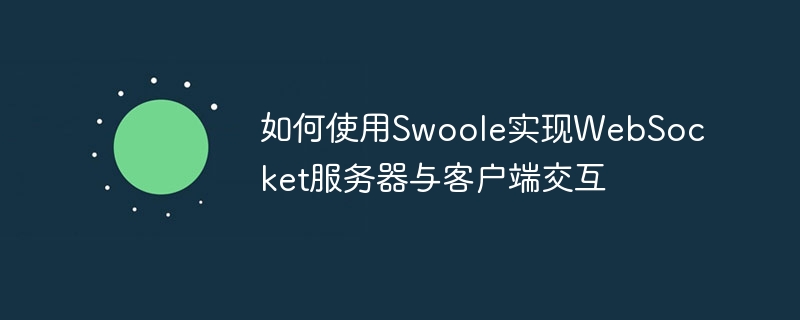

WebSocket has become a commonly used real-time communication protocol in modern web applications. Developing WebSocket servers using PHP generally requires the use of extensions such as Swoole, because it provides support for asynchronous programming, process management, memory mapping, and other WebSocket-related features. In this article, we will discuss how to use Swoole to implement WebSocket server-client interaction and provide some specific code examples.
Swoole is an excellent PHP extension that provides very good support for implementing WebSocket servers. Swoole supports asynchronous programming and multi-process and multi-thread concurrent access. It manages the server's lifecycle and provides other useful features such as memory mapping. WebSocket is a commonly used real-time communication protocol in modern Web applications. Using Swoole to develop a WebSocket server allows us to easily implement real-time communication with clients.
First you need to install the Swoole extension, which can be installed through the following command:
pecl install swoole
After installation, you need to add the following configuration to the php.ini file:
extension=swoole
After completing the above operations, you can use the Swoole extension in PHP.
Next, you need to build a WebSocket client locally. You can use some network tools or install a Chrome browser plug-in "Simple WebSocket Client".
In this process, you need to first create a Swoole WebSocket server instance and perform some basic configurations, such as setting the listening port and IP address of the WebSocket server, and also need Handle various events and data from the WebSocket server. The following is a simple example:
$server = new SwooleWebsocketServer("0.0.0.0", 9501); $server->on('open', function (SwooleWebSocketServer $server, $request) { echo "connection open: {$request->fd} "; }); $server->on('message', function (SwooleWebSocketServer $server, $frame) { echo "received message: {$frame->data} "; $server->push($frame->fd, json_encode(["hello", "world"])); }); $server->on('close', function (SwooleWebSocketServer $server, $fd) { echo "connection close: {$fd} "; }); $server->start();
In the above code, a WebSocket server instance is created using the new keyword. Its constructor needs to pass in an IP address and a port number, and Swoole will listen for WebSocket connections on this port. Then, the open, message, and close events of the WebSocket server are processed through several callback functions. Finally, call the $server->start() method to start the WebSocket server.
After creating a WebSocket server instance, you can handle all user events by rebinding the event callback. For example, we can handle the open event of a WebSocket client connection to the server by rebinding the 'open' callback function.
There are two ways for WebSocket client and server to interact: the server can push data to the client, and the client can also send data to the WebSocket server.
The server can use the $server->push() method to push data to a specific client or all clients. Here is a simple example:
$server->push($frame->fd, json_encode(["hello", "world"]));
In the above code, $frame->fd is the client's unique identifier. You can think of a WebSocket connection as a TCP connection open to the server, where the client is identified by a unique identifier ($frame->fd).
The client can use the WebSocket API written in JavaScript to send data to the server. The following is a simple JavaScript code snippet that demonstrates how to send data to a WebSocket server.
const socket = new WebSocket('ws://localhost:9501'); socket.addEventListener('open', function (event) { socket.send('Hello World!'); // 发送数据 });
The communication between the client and the server is event-based, so the received data needs to be processed through an event handler. A callback function needs to be bound to the 'message' WebSocket event, which will be responsible for processing the received data. The following is a simple example:
$server->on('message', function (SwooleWebSocketServer $server, $frame) { echo "received message: {$frame->data} "; });
The following is a complete Swoole WebSocket server example, demonstrating how to use Swoole to establish a WebSocket server and interact with the client.
Copy after login
This WebSocket server will listen and handle WebSocket connections on port 9501. You can use any WebSocket client to test and explore this server instance.
The above is the detailed content of How to use Swoole to implement WebSocket server and client interaction. For more information, please follow other related articles on the PHP Chinese website!




